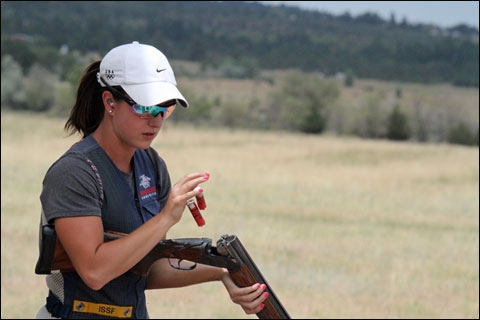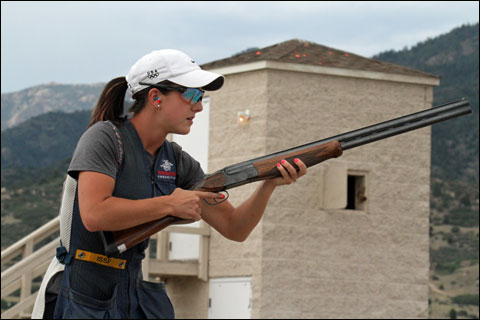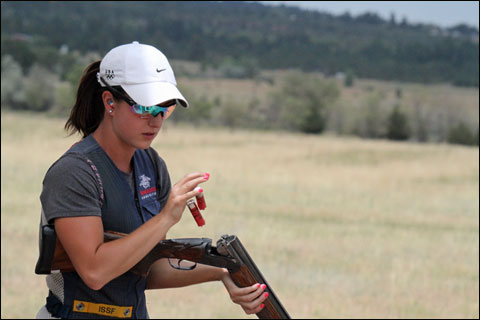Five Shotgunning Tips From the Olympic Shooters of Team USA

Here in Colorado Springs, a bright and unseasonably warm February afternoon boasted clear skies and no wind — perfect for a clays-shooting session with USA Shooting team members, skeet whiz Amber English and her trap colleagues Dakotah Richardson and Collin Wietfeldt. We also caught up with team trap shooter Kelsey Zauhar.
We convened at Fort Carson Air Force Base, located about 20 minutes from the Olympic Training Center where international skeet and trap fields had been constructed for the Olympic Center’s shooters.
I approached this opportunity with a hint of trepidation. I had never tried international skeet but had shot international bunker trap for the first time a few months before when, as the guest of Fabbri Gunmakers of Italy, Dario Anguissola let me use his new Fabbri Titanium 12 bore at the Ghedi range in the Lake Garda district of Northen Italy. Dario is former world champion in bunker trap, live pigeon shooting and helice (ZZ) competition.

Now I was back on the course with champion shooters, this time at Fort Carson. After spending time with Amber, Dakatoh and Collin, I distilled our session down to five key pointers. I trust that these insights and perspectives will prove helpful to the rest of us who reside at lower levels of the shotgun shooters’ Mount Olympus.
1. Focus, Adapt and Self-Correct
“You don’t practice until you get it right. You practice until you can’t get it wrong.” Jason Elam, All-Pro kicker, Denver Broncos
I began shooting trap with Collin and Dakotah using my Dassa-engraved Perazzi MX-8. Collin shot a Perazzi MX-8 while Dakotah shot a Beretta DT10, with his new DT11on the way.
Dakotah shot first. I studied his style. He was rhythmic and methodical. Unhurriedly, he placed two cartridges into the chambers as if placing bottles of Cabernet into a wine rack. He raised the shotgun about seventy degrees toward the sky, slowly brought it down to his shoulder, leaned forward and, after a moment, yelled “pull.” A sense of calm control emanated from every movement. Collin shot next. His method was similar to Dakotah’s. Most noticeable with both shooters were the smoothness and measured pace of their gun mount.
Amber and the trap shooters chatted with me after our first round. Dakotah explained his pre-shot routine. He breathes slowly, taking note of his breathing rate. Sometimes he counts—one, two, three, etc. — to slow his rate. After his gun is mounted, Dakotah looks downfield at objects but not at any with particularity. He uses what he calls a “soft focus.” This focus causes less strain on the eyes and can be sustained. The soft focus allows him to pick up the target more quickly.

Dakotah Richardson
The shooters are cognizant of and maximize the multiple functions of their eyes. The eyes first transmit information to the brain for analysis — target speed, distance, direction — and then the eyes perform the sharp focus on the target. Sharp focus shuts down the analytical functions of the brain, cutting off the external world with guillotine-like effectiveness. Shutting down the analytical part of the brain permits a more direct access to the thousands of presumably correct sight pictures embedded in the short and long term memories. Quicker access to stored memory information enables the brain to more rapidly communicate to the muscles the correct instant to pull the trigger.
Adapting the shooting mechanics and state of mind are essential to competition success. Amber adapts by employing a multiple-step process beginning with analyzing details such as stance, hold point, muzzle speed, whether she is hitting the front edge or the rear section of the target and so forth, and then, if justified, making appropriate changes to reinforce what she knows is right.
“Through intense training you know what the right mechanics and sight pictures are,” Amber said. “Then you must have the discipline and will to do what’s right.” This point is fundamental to success: the shooter trains herself to overcome misses by making adaptations. However, as all the shooters emphasized to me, the adaptations are based upon extensive experience.
Dakotah creatively analogized the experience-based adaptation process to taking an exam. “If you know the material you are going to be tested on, you can study in a focused manner and not study the stuff that won’t matter.”
“The best coaches,” Collin emphasized, “teach how to analyze errors and fix them on your own. From hundreds of thousands of repetitions, you know — or should know — if the elbow is too high or the knees are too bent, and, therefore, you can self-correct sooner. When you are in a match, the coach can’t help you. If you are having trouble and you lose a few targets, it may be too late to catch up. There is no margin for error.”
Dakotah saw an irony in the self-correcting process. “Experience is a mean teacher,” he told me. “You get the test first and then try to learn the lesson afterwards.” He added, “You are your own teacher. You are the only one who can read your brain as situations develop. The more you challenge yourself, the better you will be.”
2. Move Faster, Shoot More Quickly
“The way to develop self-confidence is to do the thing you fear and get a record of successful experiences behind you. Destiny is not a matter of chance, it is a matter of choice; it is not a thing to be waited for, it is a thing to be achieved.” — William Jennings Bryant (1860-1925), statesman, writer, essayist, critic
I learned three technical tips when Amber instructed me when we shot skeet. Each technique may be rightly seen as fine tuning or grace notes for elevating one’s level of excellence. Amber shot a few stations, singles and doubles, to illustrate the rhythm of the game.
For those of you who are new to the discipline, the targets fly faster in international skeet, have a denser clay composition and reinforced edges and are released with up to a three-second delay after the competitor boldly yells “pull.”
I began at station 1. The target flashed out of the high house like a cruise missile, giving the impression that, if missed, it would likely end up on the Long Island Expressway. I shot a high and low house and turned those presumptuous disks into dust. Lamentably, when I shot the doubles, success ran off like a relative who owes you money, leaving me as deflated as if my trophy trout spit out the fly. It is one thing to know that the challenge of international skeet is daunting. It is quite another to experience how daunting the challenge actually is.

Amber quickly intervened after I fired a few shots. Her first tip was the combination instruction to move and shoot more quickly. I was riding the target. As a consequence, I did not shoot the targets at their optimal position or, with some doubles, I did not shoot the second target at all. Riding an international skeet target is like riding a lightning bolt: the ride is quite brief. Amber’s point, which I accepted as true, was that I was not shooting when I knew — that is, when my brain, or what’s left of it — recognized the correct sight picture. I waited. I hesitated. Thus, I was playing catch-up, which is not a productive strategy.
There are reasons for my hesitation, some more justifiable than others. I don’t shoot very much. My shots-per-year are insignificant compared with these folks. Dakotah, for example, informed that he put about one-million rounds through his Beretta in the last four years. In four years I may shoot eight thousand rounds. The difference matters.
Of course the reflexes of these athletes are faster, but quicker reflexes are not the most critical advantageous variable. Their hundreds of thousands of successful shots embed accurate sight pictures in their brains. Lacking those images in my short and long term memories, my brain had insufficient data to draw upon to signal the earliest instant to shoot. Thus, I had to think about it. I had doubts. Doubt and analysis slow you down.
Additionally, increased shooting speed is the result of tens of thousands of rounds fired under focused, intense disciplined training. Confidence and reflexes are methodically developed that way also. Collin correctly opined that confidence is based on achievement and achievement must be earned. Achievement is the result of hard work.
Amber graciously and patiently made another point: that I would not improve unless I shot more quickly. I had to get out of my comfort zone (which, frankly, was not very comfortable to begin with) and train the mind to direct the muscles to press the trigger exactly when the proper sight picture is first identified.
Mastering this skill would require geometrically increasing my shooting volume, but no matter how many cartridges I fired, the facts are that I would not improve unless I pushed harder than I ever had and that I must accept the painful reality that I would shoot worse before I improved. This may seem counter-intuitive but there is no other way to increase the excellence level of performance.
3. Stop Boxing!
“More people have talent than discipline. That’s why discipline pays better.”— Mike Price, writer
I had moved on to station 8 and Amber graciously continued her patient instruction. She watched me closely and then told me I was “boxing.” I assured her I was not. “Yes you are,” she responded impassively. Amber pointed out that, during the gun mount, I did not bring the butt of the stock directly up to the shoulder. She observed that, in the low gun position, I held the stock to the right of the correct shoulder placement and, as I raised the stock to my shoulder, I moved the stock to the left and then up, making two motions instead of one.

This subtle imperfection of technique caused excess barrel movement at the muzzle, creating a lateral momentum that had to be overcome to regain perfect muzzle control. This excess movement inefficiently slowed the gun on its path to the proper firing position.
Perhaps the most significant negative consequence of this “boxing” was its tendency to prevent me from consistently keeping my head on the stock. Lifting one’s head off the stock is among the greatest of shooting errors and inconsistently contacting the stock most assuredly leads to inferior performance. The negative consequences of my “boxing” were most egregious on station 8, where time and disciplined efficient gun dynamics are at the greatest premium.
4. Pushing Rather than Leading
“There is no great champion without great will.” — Gunde Svan, Olympic Gold Medal Nordic skier.
Another refinement of technique Amber corrected was my tendency to push the gun at the butt stock. I was manipulating the stock with my right shoulder rather than directing the gun by pulling or pushing it at the fore end. Pushing the gun to the right at the fore end (I am right handed) and pulling the gun to the left at the fore end yields a more direct and, thus, efficient, movement to the target’s line. Pushing at the shoulder causes the muzzle to move more like a sine curve, up and down, rather than moving in a linear flat plane. Thus, the gun is slower in getting to the target’s line.
Amber affirmed that every component of the shooting process fluidly flows into all others, blending like the colors of a rainbow, creating the requisite harmony and efficiency for attaining Olympic-level performance.

Collin reinforced this interrelationship of the scrupulous dynamism of gun movements, saying “A lot of small things can make a huge difference.”
5. Managing Pressure
You gain strength, courage and confidence by every experience in which you really stop to look fear in the face. You must do the thing which you think you cannot do — Anna Eleanor Roosevelt
When you step into the shooting cage or onto the square shooting pad with the intent to win an international medal, expectations transcend the ordinary nature of most outings. Pressure at volcanic levels pervades the body and mind. Thus, the art of the successful competitive shooter is managing pressure. Pressure is managed by controlling expectations and drawing upon skills learned through hard work. Both are influenced by the oft-heard phrase “mental toughness.” Indeed, volumes have been written about it.
Collin said Kim Rhode is perhaps the most mentally tough athlete he’s met. “What does that mean?” I asked. Amber said mental toughness includes creating in people “the perception that you are unshakeable or unbreakable; an aura, like you are a mental rock.” That’s quite a perception!
Mental toughness and concentration progress over time, Amber said. The most significant characteristic for training the mind, Collin told me, “is believing in and trusting your ability, particularly under pressure.”
We have read, no doubt, how many shotgun shells Kim shoots a year ever since she was a rather young child. But the number of shells Kim fires may well not be the variable that led to her stunning and consistent success. As trap shooter Kelsey Zauhar stated to me most emphatically, “You can’t give someone 100,000 shells and say, “Go win a medal!” and expect that it will produce a medal.”
As an example of processes that go beyond how many times a shooter pulls the trigger, in preparation for the 2012 Olympic Games, I was told that Kim also focused on details and adversity. She trained using the same brand of targets, when possible, often at venues that had the same or similar geographic properties that duplicated the London range. She prepared in cold weather and in wind and rain. She created training experiences that generated pressure and the flow of adrenaline.
Kim’s near-fanatical attention to detail is called “work.” Working hard means creating and sustaining a shooting environment that approximates competitive match pressures, physiologically and mentally. It means shooting when you are tired, when you are behind in mortgage payments and when a family member is in hospice care. It means never surrendering to obstacles to pursuing your goals.
Success at the highest levels of competition requires adapting one’s mechanics and controlling pressure by controlling one’s mind. Kelsey gave me a profound insight into a state of mind that can successfully deal with pressure and manage expectations. “Trust must be based on a history of achievement, and achievement is based on training,” Kelsey said. But achievement and training are not enough, she added.
She explained that you have “to rely on the fundamentals and whatever methods you use to calm yourself. If you try to shoot consciously or analytically, you will fail. There are too many variables that can go wrong.”
Then Kelsey explained the core principle of her mental discipline for handling pressure. “Pressure is handled by perspective. If I lose, I won’t fall down dead; no one will die; a war will not be won or lost; my parents will still love me.” When she gained this perspective, she said, she started to achieve success.
“My concern,” Kelsey said, “is not that I hit the most targets but that I was an honorable competitor. When I look at my medals, I see traits. It’s more than dreaming about goals and achieving goals.” Kelsey paused and then spoke slowly, as if kneading her thoughts like brioche dough. “As you improve, the act of shooting plays less of a role in success. Every shot is leading toward something, toward realizing the value and the purpose. Every shot has a value toward a goal.”
Conclusion
I have shared much of what I have learned about the skills and mindsets of these extraordinary and complex athletes. They are tough competitors, mentally and physically, and they have been gracious and, indeed, modest, with me. Above all I noted the application in their training of Aristotle’s maxim that “Excellence is not an act but a habit.”
Of course, I asked each shooter why they liked to shoot. Their answers varied, but all included enjoying the thrill of competition and the collegiality inherent in the shooting sports. Beyond that, their attitude was something like that expressed in the comment legendary jazz musician and composer Fats Waller made to a fan when she asked him, “Why jazz?” Fats replied, “Lady, if you have to ask, you’ll never know.”
Michael Sabbeth is a lawyer in Denver, Colorado. He lectures on ethics and rhetoric to law associations and civic and business groups. He is the author of the The Good, The Bad & The Difference: How to Talk with Children About Values. Please visit his website at www.kidsethicsbook.com.
Useful Resources:
Dakotah Richardson’s Facebook page
Collin Wietfeldt’s Facebook page

Michael Sabbeth is a lawyer in Denver, Colorado. He lectures on ethics and rhetoric to law associations and civic and business groups. He is the author of the The Good, The Bad & The Difference: How to Talk with Children About Values. Please visit his website at www.kidsethicsbook.com.


Comments